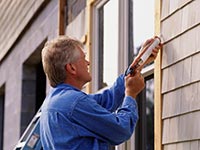Staying Fit
Spending a few hours this fall to button up your house and other valuables for the winter can save you big bucks down the line. There are plenty of easy and inexpensive ways to protect your possessions from harsh winter weather. Here's a checklist of preventive measures to consider before it turns cold:


Driveways, sidewalks and patios: Little cracks in concrete surfaces can quickly grow into big ones during the winter with the constant freezing and thawing of trapped moisture. Sealing cracks with ready-to-use concrete sealant is quick and easy: Just apply with a caulking gun or squeeze directly from the tube. A one-quart tube of sealant should cost under $10 at most home improvement stores and it goes a long way. By the way, rock salt used for winter snow and ice removal can erode concrete surfaces and kill surrounding grass and plants, so use deicing products that are safe for your surfaces and landscaping.


AARP Membership— $12 for your first year when you sign up for Automatic Renewal
Get instant access to members-only products and hundreds of discounts, a free second membership, and a subscription to AARP the Magazine.
Gas grills: If you're through grilling for the season, turn off and disconnect the propane tank and store it separately, as winter cold is hard on the flexible tubing and can cause cracking, especially if it's still under pressure. Open burner valves to bleed off any trapped gas. Clean grates, flavor bars and grease trap using a wire brush and soapy water; add a little ammonia to help cut the grease. Be sure to clean out any ashes on the bottom of the grill because they'll trap moisture and may rust during the winter. Ideally, cover the grill and store indoors or in a dry outdoor location. If you store it outdoors, wrap the burners in plastic bags to keep moisture out and then cover the entire grill in a sturdy vinyl grill cover, which typically costs under $40 at home stores.
Lawnmowers/gas-powered garden equipment: Lawnmowers and other gas-powered garden equipment should be thoroughly cleaned, removing all caked-on grass, dirt and loose rust. A simple scrub pad made from repurposed aluminum foil works well for this job, particularly when used with a spray lubricant such as WD-40. Air and fuel filters should be changed, along with the oil. Most experts agree that the gas tank should be kept filled with gasoline that has been treated with a stabilizer, available at many hardware and auto supply stores. This keeps the gas fresh and prevents condensation and deposits from developing in the engine. Be sure to run the engine for about 10 minutes after adding the stabilized gasoline.

































































More on money
How to File an Amended Tax Return
Get income tax refunds from previous years or fix mistakes